Quantifying Water Storage Changes and Groundwater Drought in the Huaihe River Basin of China Based on GRACE Data
Abstract
:1. Introduction
2. Materials and Methods
2.1. Study Area
2.2. Materials
2.2.1. GRACE and GRACE FO RL06 Mascon Gravity Satellite Data
2.2.2. GLDAS-Noah Data
2.3. Methods
2.3.1. Groundwater Storage Anomalies
2.3.2. Calculation of Groundwater Drought Index Based on GRACE Data
2.3.3. Theil-Sen Slope Estimation
2.3.4. Mann-Kendall Trend Test
2.3.5. Drought Identification
3. Results and Analysis
3.1. Trend Analysis of Terrestrial and Surface Water Storage Anomalies
3.1.1. Trend of Terrestrial Water Storage Anomalies
3.1.2. Trend of Surface Water Storage Anomalies
3.2. Calculation and Trend Analysis of Groundwater Storage Anomalies
3.2.1. Calculation and Verification of Groundwater Storage Anomalies
Calculation of Groundwater Storage Anomalies
Verification of Groundwater Storage Anomalies
3.2.2. Trend Analysis of Groundwater Storage Anomalies
3.3. Groundwater Drought Characteristics
3.3.1. Drought Frequency, Total Duration, and Total Intensity
3.3.2. Maximum Duration and Intensity
3.3.3. Average Drought Duration and Average Intensity
4. Discussion
4.1. Water Storage Anomalies
4.2. Drought Characteristics
4.3. Limitations and Recommendations
5. Conclusions
Author Contributions
Funding
Institutional Review Board Statement
Informed Consent Statement
Data Availability Statement
Acknowledgments
Conflicts of Interest
References
- Ai, Q. Construction and Application of Standard Groundwater Index. Master’s Thesis, Northwest A&F University, Xianyang, China, 2020. [Google Scholar] [CrossRef]
- Chu, J. Spatio-Temporal Evolution Characteristics of Groundwater Drought in Northwest China and Its Response to Meteorological Drought and Temperature Index. Master’s Thesis, Northwest A&F University, Xianyang, China, 2022. [Google Scholar] [CrossRef]
- Mishra, A.K.; Singh, V.P. A review of drought concepts. J. Hydrol. 2010, 391, 202–216. [Google Scholar] [CrossRef]
- Bloomfield, J.P.; Marchant, B.P.; Bricker, S.H.; Morgan, R.B. Regional analysis of groundwater droughts using hydrograph classification. Hydrol. Earth Syst. Sci. 2015, 19, 4327–4344. [Google Scholar] [CrossRef]
- Han, Z.; Huang, S.; Huang, Q.; Leng, G.; Wang, H.; He, L.; Fang, W.; Li, P. Assessing GRACE-based terrestrial water storage anomalies dynamics at multi-timescales and their correlations with teleconnection factors in Yunnan Province, China. J. Hydrol. 2019, 574, 836–850. [Google Scholar] [CrossRef]
- Zeng, Y.; Xie, Z.; Yu, Y.; Liu, S.; Wang, L.; Jia, B.; Qin, P.; Chen, Y. Ecohydrological effects of stream-aquifer water interaction: A case study of the Heihe River basin, northwestern China. Hydrol. Earth Syst. Sci. 2016, 20, 2333–2352. [Google Scholar] [CrossRef]
- Moghim, S. Assessment of Water Storage Changes Using GRACE and GLDAS. Water Resour. Manag. 2020, 34, 685–697. [Google Scholar] [CrossRef]
- Sediqi, M.N.; Shiru, M.S.; Nashwan, M.S.; Ali, R.; Abubaker, S.; Wang, X.; Ahmed, K.; Shahid, S.; Asaduzzaman, M.; Manawi, S.M.A. Spatio-temporal pattern in the changes in availability and sustainability of water resources in Afghanistan. Sustainability 2019, 11, 5836. [Google Scholar] [CrossRef]
- Thomas, B.F.; Famiglietti, J.S.; Landerer, F.W.; Wiese, D.N.; Molotch, N.P.; Argus, D.F. GRACE Groundwater Drought Index: Evaluation of California Central Valley groundwater drought. Remote Sens. Environ. 2017, 198, 384–392. [Google Scholar] [CrossRef]
- Hosseini-Moghari, S.M.; Araghinejad, S.; Ebrahimi, K.; Tourian, M.J. Introducing modified total storage deficit index (MTSDI) for drought monitoring using GRACE observations. Ecol. Indic. 2019, 101, 465–475. [Google Scholar] [CrossRef]
- Satish Kumar, K.; AnandRaj, P.; Sreelatha, K.; Bisht, D.S.; Sridhar, V. Monthly and Seasonal Drought Characterization Using GRACE-Based Groundwater Drought Index and Its Link to Teleconnections across South Indian River Basins. Climate 2021, 9, 56. [Google Scholar] [CrossRef]
- Cui, L.; He, M.; Zhang, C.; Zou, Z.; Wang, X. Using GRACE/GRACE-FO time variable gravity field data to quantify the characteristics of drought events in the Yangtze River Basin. Bull. Surv. Mapp. 2022, 5, 45–48+55. [Google Scholar] [CrossRef]
- He, G. Water Storage Variation Inversion and Analysis in North China Plain Based on GRACE RL06. Geospat. Inf. 2022, 20, 55–59. [Google Scholar]
- Li, M.; Chen, L.; Liu, G.; Mao, W.; Xiang, W.; Cai, J.; Zhang, B.; Zhang, R. Groundwater storage data inversion and spatiotemporal evolution analysisin Henan province using GRACE and GLDAS data. Bull. Surv. Mapp. 2022, 25, 121–126. [Google Scholar] [CrossRef]
- Zhang, H.; Ding, J.; Zhu, Q.; Wang, G.Q. Analysis on spatial—Temporal characteristic of groundwater drought based on GRACE in North China Plain. Yangtze River 2021, 52, 107–114. [Google Scholar] [CrossRef]
- Su, X.; Chu, J.; Zhang, T.; Jiang, T.; Wang, G. Spatio-temporal evolution trend of groundwater drought and its dynamic response to meteorological drought in Northwest China. Water Resour. Prot. 2022, 38, 34–42. [Google Scholar]
- Ruan, Y.; Wu, X. Evaluation of groundwater resource sustainability based on GRACE and GLDAS in arid region of Northwest China. Arid. Zone Res. 2022, 39, 787–800. [Google Scholar] [CrossRef]
- Yan, S.Y.; Weng, B.S.; Jing, L.S.; Meng, L.I. Spatial and Temporal Distribution Characteristics of Droughts in Huaihe River Basin. China Rural. Water Hydropower 2021, 4, 160–165+170. [Google Scholar]
- Wen, Z.; Yin, Y.X.; Zou, R.; Wang, X.J. Hydrological and Meteorological Drought Indices and Their Relationship with His-torical Drought in the Huai River Basin from 1960 to 2014. China Rural. Water Hydropower 2021, 2, 71–77. [Google Scholar]
- Zhong, Y.; Feng, W.; Humphrey, V.; Zhong, M. Human-induced and climate-driven contributions to water storage variations in the Haihe River Basin, China. Remote Sens. 2019, 11, 3050. [Google Scholar] [CrossRef]
- Zhong, Y.; Feng, W.; Zhong, M.; Ming, Z. Dataset of Reconstructed Terrestrial Water Storage in Mainland China Based on Precipitation (2002–2019); National Tibetan Plateau/Third Pole Environment Data Center: Beijing, China, 2020; Available online: https://cstr.cn/18406.11.Hydro.tpdc.270990 (accessed on 1 September 2023). [CrossRef]
- Wang, S.; Liu, H.; Yu, Y.; Zhao, W.; Yang, Q.; Liu, J. Evaluation of groundwater sustainability in the arid Hexi Corridor of Northwestern China, using GRACE, GLDAS and measured groundwater data products. Sci. Total Environ. 2020, 705, 135829. [Google Scholar] [CrossRef] [PubMed]
- Zhao, M.; Geruo, A.; Velicogna, I.; Kimball, J.S. A global gridded dataset of GRACE drought severity index for 2002-14: Comparison with PDSI and SPEI and a case study of the Australia Millennium drought. J. Hydrometeorol. 2017, 18, 2117–2129. [Google Scholar] [CrossRef]
- Sen, P.K. Estimates of the regression coefficient based on Kendall’s Tau. J. Am. Stat. Assoc. 1968, 63, 1379–1389. [Google Scholar] [CrossRef]
- Nan, L.; Yang, M.; Hao, S. Analysis of temporal and spatial distribution characteristics of precipitation in Chongqing City from 1965 to 2014. Yangtze River 2021, 52, 64–69. [Google Scholar] [CrossRef]
- Yuan, L.H.; Jiang, W.G.; Shen, W.M.; Liu, Y.H.; Wang, W.J.; Tao, L.L.; Zheng, H.; Liu, X.F. The spatio-temporal variations of vegetation cover in the Yellow River Basin from 2000 to 2010. Acta Ecol. Sin. 2013, 33, 7798–7806. [Google Scholar]
- Yue, S.; Pilon, P.; Cavadias, G. Power of the Mann-Kendall and Spearman’s rho tests for detecting monotonic trends in hydrological series. J. Hydrol. 2002, 259, 254–271. [Google Scholar] [CrossRef]
- Pathak, A.A.; Dodamani, B.M. Trend analysis of groundwater levels and assessment of regional groundwater drought: Ghataprabha River Basin, India. Nat. Resour. Res. 2018, 28, 631–643. [Google Scholar] [CrossRef]
- Thomas, B.F.; Famiglietti, J.S. Identifying climate-induced groundwater depletion in GRACE observations. Sci. Rep. 2019, 9, 4124. [Google Scholar] [CrossRef] [PubMed]
- Wang, X.; Zhang, Y.; Feng, X.; Feng, Y.; Xue, Y.; Pan, N. Analysis and application of drought characteristics based on run theory and Copula function. Trans. Chin. Soc. Agric. Eng. (Trans. CSAE) 2017, 33, 206–214. [Google Scholar]
- Chen, Z.; Hou, W.; Zuo, D.; Hu, J. Research on Drought Characteristics in China Based on the Revised Copula Function. Arid. Meteorol. 2016, 34, 213–222+268. [Google Scholar]
- Fleig, A.K.; Tallaksen, L.M.; Hisdal, H.; Demuth, S. A global evaluation of streamflow drought characteristics. Hydrol. Earth Syst. Sci. 2006, 10, 535–552. [Google Scholar] [CrossRef]
- Zhao, Y.; Shen, Q.; Feng, W.; Wang, H.; Gao, F.; Lai, W.; Liu, T. Changes and Spatio-Temporal Characteristics of Terrestrial Water Storage Variation in China’s Seven Main River Basins During 2002–2018. J. Geod. Geodyn. 2022, 42, 796–801. [Google Scholar]
- Li, X.; Wu, S.; Wang, Y.; Cui, W. Analysis of terrestrial water storage and drought indices in the Huaihe River Basin. Water Resour. Prot. 2020, 36, 80–85. [Google Scholar]
- Wu, S.; Li, X.; Zheng, H.; Wang, Y. Research on terrestrial water storage anomaly based on satellite remote sensing data and set pair analysis in Huaihe River Basin. J. Water Resour. Water Eng. 2019, 30, 81–85. [Google Scholar]
- Feng, W.; Zhong, M.; Lemoine, J.M.; Biancale, R.; Hsu, H.T.; Xia, J. Evaluation of Groundwater Depletion in North China Using the Gravity Recovery and Climate Experiment (GRACE) Data and Ground-Based Measurements. Water Resour. Res. 2013, 49, 2110–2118. [Google Scholar] [CrossRef]
- Zhou, Z.C.; Wang, W.P.; Li, B.Y. Research on Groundwater Reserve Variation Regulations in Huaihe Basin Based on GRACE Temporal Gravity Field. Int. J. Hydroelectr. Energy 2017, 35, 37–41. [Google Scholar]
- Wang, K.; Li, Y.; Li, C.; Lai, Y.; Yang, C. Variations in groundwater storage in the Huang-Huai-Hai region and attribution analysis based on GRACE data. Hydro-Sci. Eng. 2023, 6, 24–34. [Google Scholar] [CrossRef]
- Yan, Y.; Yue, Y.; Tang, Z.; Tang, X.; Shen, W.; Wang, W.; Meng, H.; Yao, H. Characteristics of Drought Evolution in the Huaihe River Basin Under the Background of Climate Change. Res. Soil Water Conserv. 2023, 30, 336–344. [Google Scholar]
- Chu, J.; Su, X.; Jiang, T.; Hu, X.; Wu, H. Application Status and Prospect of Water Storage and Drought Monitoring based on GRACE Data. Remote Sens. Technol. Appl. 2023, 38, 1003–1016. [Google Scholar]
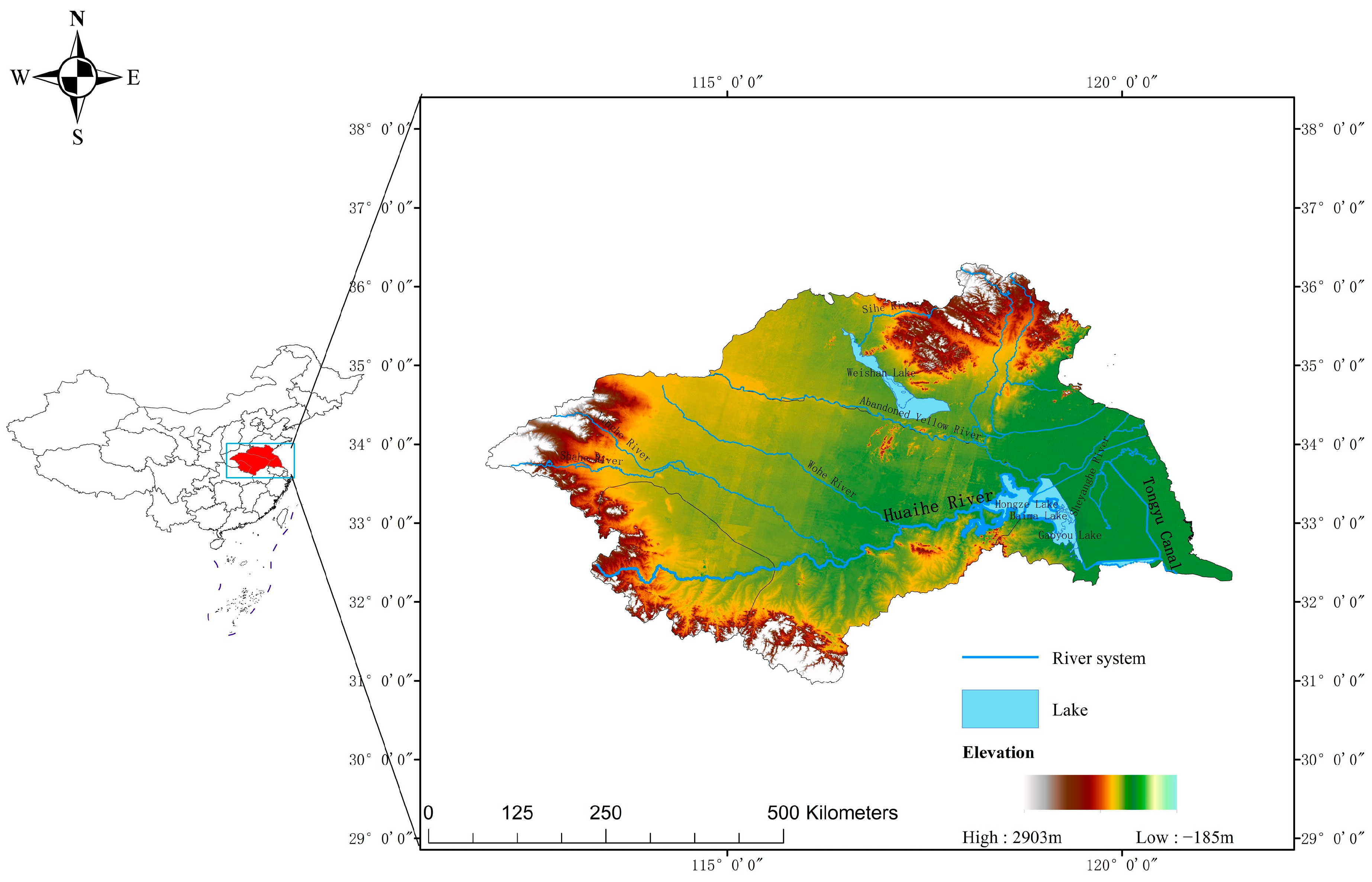
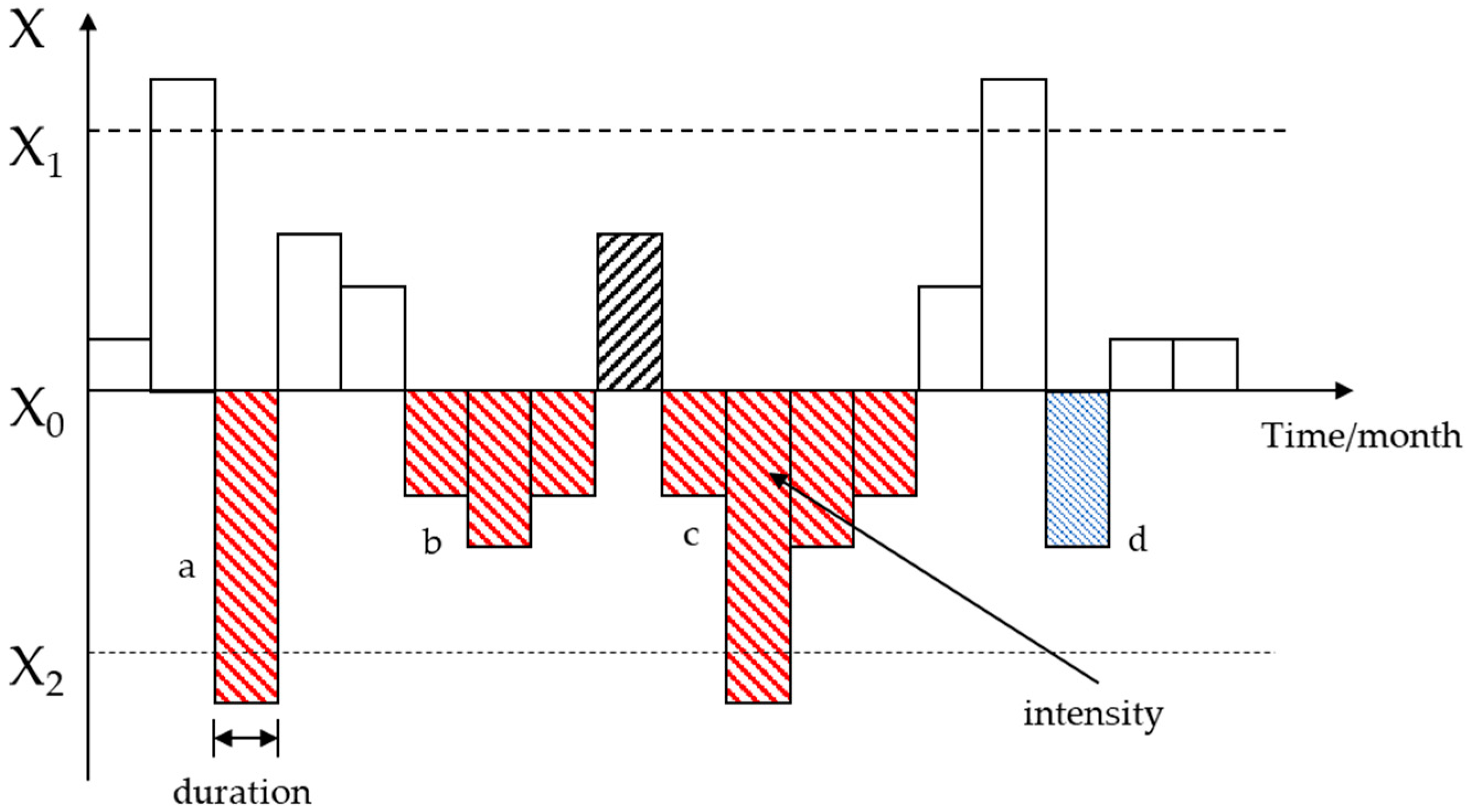
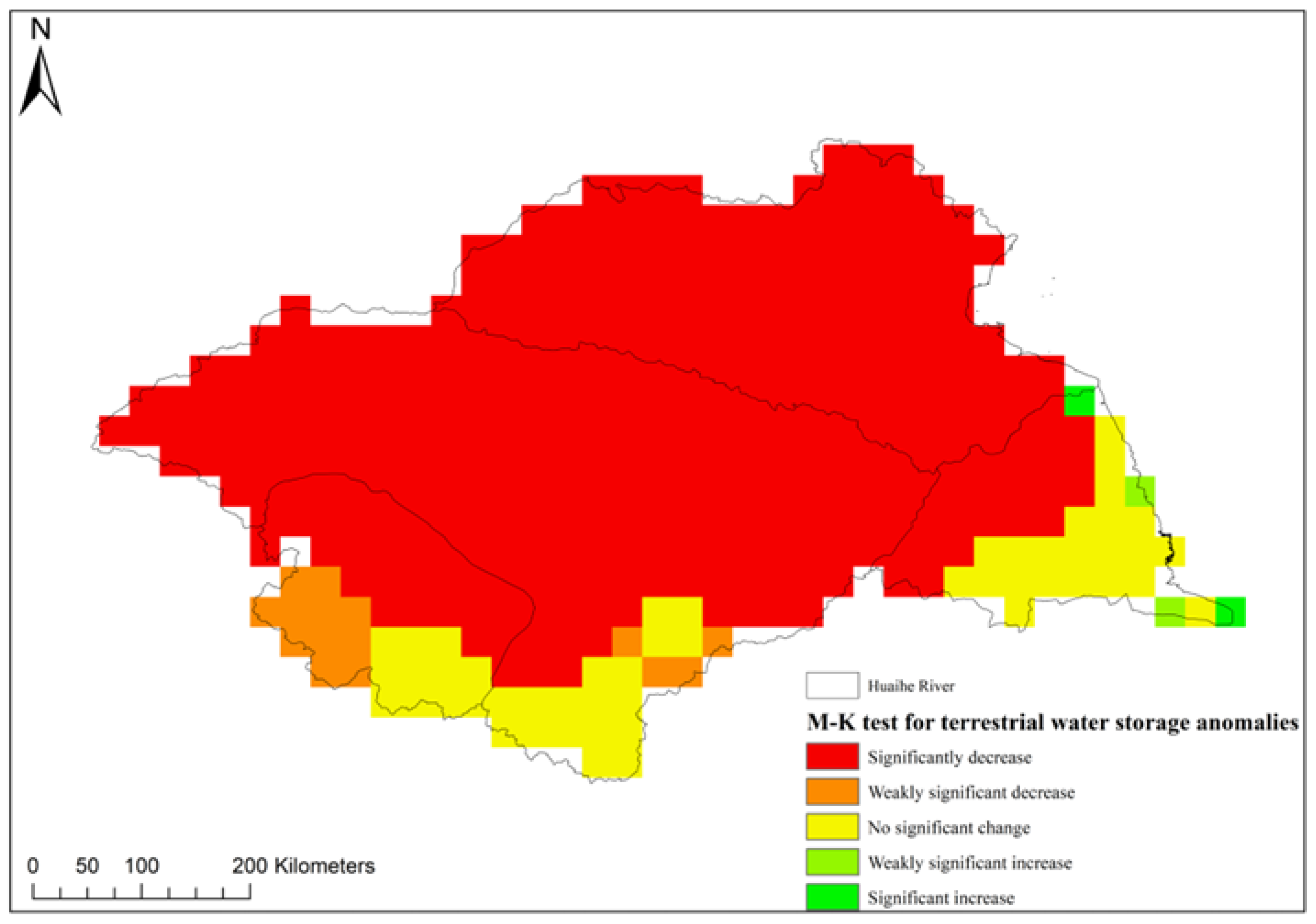


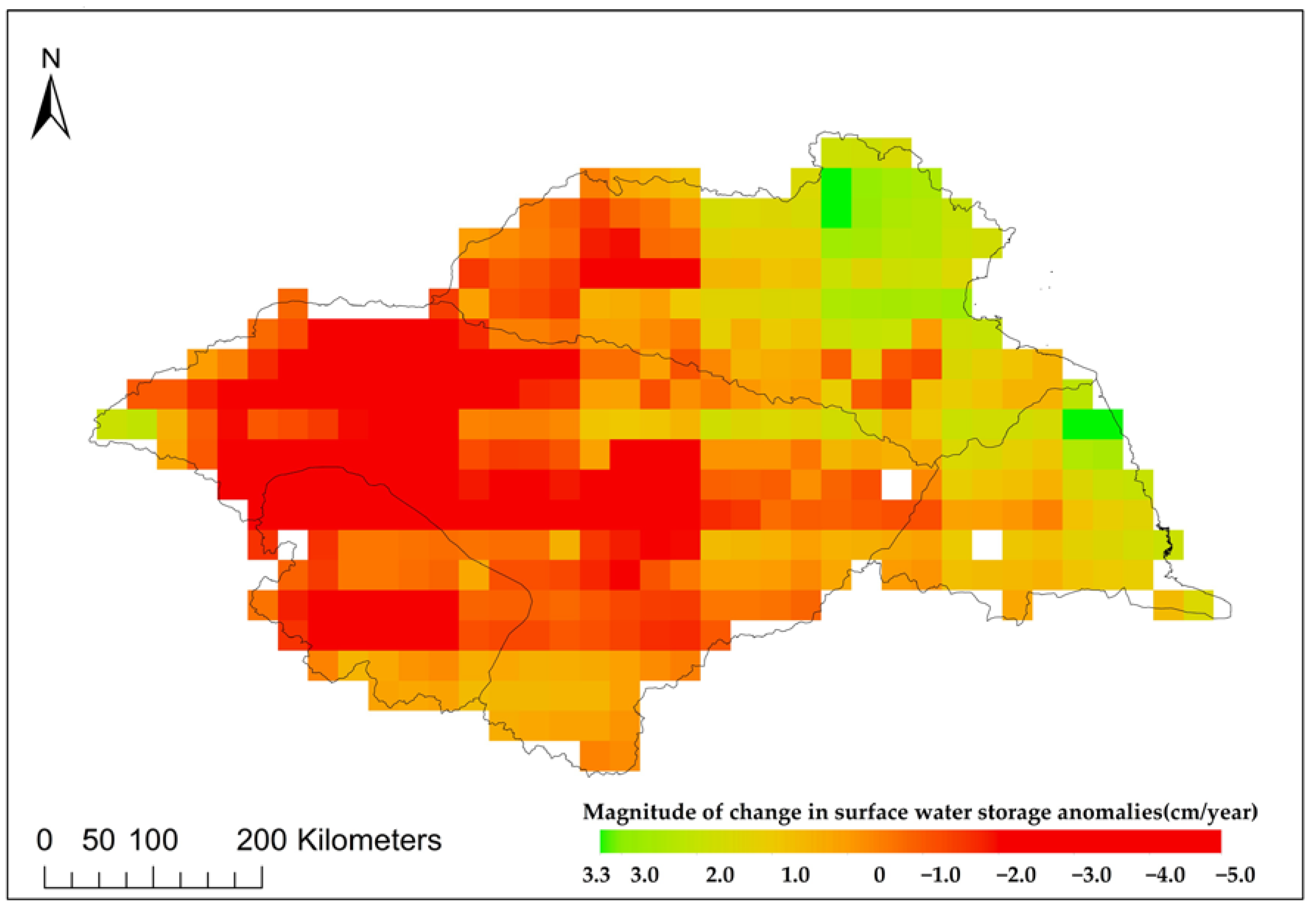





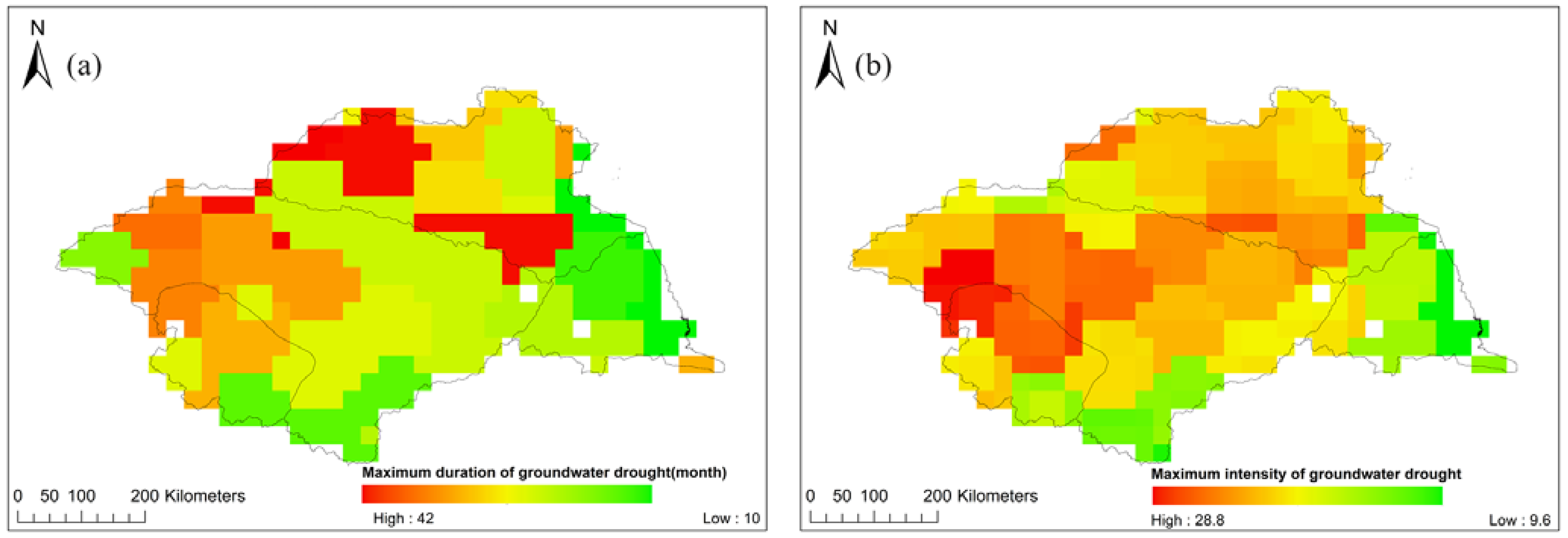
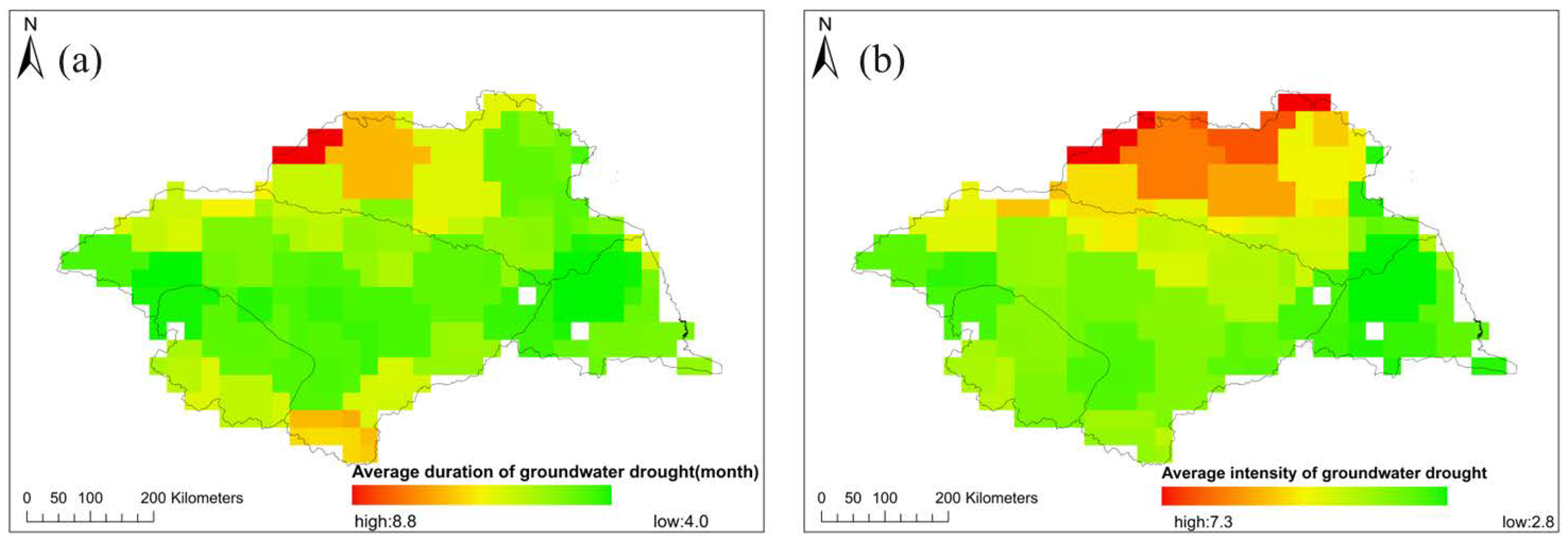
| Trend | Upstream | Middlestream | Downstream | Yi-Shu-Si River | Total |
|---|---|---|---|---|---|
| Significant decrease | 27 | 175 | 24 | 123 | 349 |
| Weakly significant decrease | 11 | 4 | 0 | 0 | 15 |
| No significant change | 11 | 18 | 22 | 0 | 51 |
| Weakly significant increase | 0 | 0 | 2 | 0 | 2 |
| Significantly increased | 0 | 0 | 2 | 0 | 2 |
| Total | 49 | 197 | 50 | 123 | 419 |
| Trend | Upstream | Middlestream | Downstream | Yi-Shu-Si River | Total |
|---|---|---|---|---|---|
| Significant decrease | 19 | 71 | 0 | 2 | 92 |
| Weakly significant decrease | 7 | 19 | 0 | 4 | 30 |
| No significant change | 23 | 100 | 28 | 74 | 225 |
| Weakly significant increase | 0 | 5 | 8 | 16 | 29 |
| Significantly increased | 0 | 2 | 14 | 27 | 43 |
| Total | 49 | 197 | 50 | 123 | 419 |
| Station Code | Station Name | Longitude | Latitude | Correlation Coefficient |
|---|---|---|---|---|
| 40177397 | Guo Yukai Lankao No. 2 | 114.7651° E | 34.82942° N | 0.69 |
| 50261127 | Guo Yuzhu Queshan No. 2 | 114.0482° E | 32.59691° N | 0.57 |
| 50261551 | Guo Yuzhu Zhengyang No. 2 | 114.3159° E | 32.47336° N | 0.66 |
| 50261869 | Guo Yuzhu Zhengyang No. 7 | 114.3269° E | 32.38529° N | 0.61 |
| 50370040 | Aiting | 115.2387° E | 32.68268° N | 0.61 |
| 50465040 | Huoqiu | 116.2962° E | 32.36457° N | 0.45 |
| 50465080 | Hongji | 116.1771° E | 31.90755° N | 0.45 |
| 50971160 | Qiuji | 118.314° E | 32.83671° N | 0.36 |
| 50971200 | Taiping | 118.4673° E | 33.52594° N | 0.48 |
| 51162049 | Xiaogu Town | 119.4256° E | 35.33786° N | 0.45 |
| 51162073 | Taoge | 119.3772° E | 35.28697° N | 0.68 |
| Trend | Upstream | Middlestream | Downstream | Yi-Shu-Si River | Total |
|---|---|---|---|---|---|
| No significant change | 26 | 45 | 17 | 7 | 95 |
| Weakly significant increase | 16 | 10 | 9 | 0 | 35 |
| Significantly increased | 7 | 142 | 24 | 116 | 289 |
| Total | 49 | 197 | 50 | 123 | 419 |
| Significantly increased | 0 | 0 | 2 | 0 | 2 |
| Total | 49 | 197 | 50 | 123 | 419 |
Disclaimer/Publisher’s Note: The statements, opinions and data contained in all publications are solely those of the individual author(s) and contributor(s) and not of MDPI and/or the editor(s). MDPI and/or the editor(s) disclaim responsibility for any injury to people or property resulting from any ideas, methods, instructions or products referred to in the content. |
© 2024 by the authors. Licensee MDPI, Basel, Switzerland. This article is an open access article distributed under the terms and conditions of the Creative Commons Attribution (CC BY) license (https://creativecommons.org/licenses/by/4.0/).
Share and Cite
Zhou, Z.; Lu, B.; Jiang, Z.; Zhao, Y. Quantifying Water Storage Changes and Groundwater Drought in the Huaihe River Basin of China Based on GRACE Data. Sustainability 2024, 16, 8437. https://doi.org/10.3390/su16198437
Zhou Z, Lu B, Jiang Z, Zhao Y. Quantifying Water Storage Changes and Groundwater Drought in the Huaihe River Basin of China Based on GRACE Data. Sustainability. 2024; 16(19):8437. https://doi.org/10.3390/su16198437
Chicago/Turabian StyleZhou, Zunguang, Baohong Lu, Zhengfang Jiang, and Yirui Zhao. 2024. "Quantifying Water Storage Changes and Groundwater Drought in the Huaihe River Basin of China Based on GRACE Data" Sustainability 16, no. 19: 8437. https://doi.org/10.3390/su16198437






